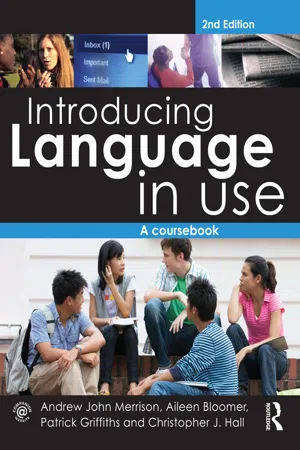
Introducing Language in Use
A Course Book
- 456 pages
- English
- ePUB (mobile friendly)
- Available on iOS & Android
Introducing Language in Use
A Course Book
About This Book
Introducing Language in Use, second edition, provides a lively and accessible introduction to the study of language and linguistics. Drawing on a vast range of data and examples of language in its many forms, this book provides students with the tools they need to analyse real language in diverse contexts.
The second edition of this best-selling textbook has been fully revised and updated with entirely new chapters on Phonology and Sociolinguistics, two separate chapters on syntax and grammar, completely rewritten chapters on Multilingualism, Psycholinguistics and World Englishes, and a greater focus on corpus linguistics.
Introducing Language in Use:
-
- covers all the core areas and topics of language study, including semiotics, communication, grammar, phonetics, phonology, words, semantics, variety in language, history of English, world Englishes, multilingualism, psycholinguistics, sociolinguistics, language acquisition, conversation analysis, pragmatics and politeness
-
- adopts a 'how to' approach, encouraging students to apply their knowledge as they learn it
-
- draws on examples of language from around the world in forms ranging from conversation to advertising and text messaging, always giving precedence to real language in use
-
- includes activities throughout the text and an extensive glossary of terms
The book is supported by a companion website offering a wealth of additional resources including commentaries on the activities in the book, suggested further reading and references, links to useful websites, more texts to analyse, additional web activities, 'fun with language' exercises, discussion questions and an additional 'Language in Education' chapter.
This is an essential coursebook for all introductory courses in English language, communication and linguistics.
Visit the companion website at www.routledge.com/cw/merrison
Frequently asked questions
Information
Table of contents
- Cover
- Title
- Copyright
- Dedication
- Contents
- List of Figures
- List of Tables
- List of Texts
- Preface to the Second Edition
- Acknowledgements
- Permissions
- List of Symbols and Abbreviations
- Prologue
- Read Me!
- 1 Language, Communication and Semiotics
- 2 Conversation Analysis: Talk-in-lnteraction
- 3 Pragmatics
- 4 Power and Politeness
- 5 Words
- 6 Semantics
- 7 Syntax: Word to Clause
- 8 Grammar: Clause to Text
- 9 Phonetics I: Voiceless Sounds
- 10 Phonetics II: Voiced Sounds
- 11 Phonology
- 12 Variety in Language
- 13 Sociolinguistics
- 14 Psycholinguistics
- 15 Language Acquisition
- 16 Multilingualism
- 17 History of English
- 18 World Englishes
- Epilogue
- Glossary
- Index